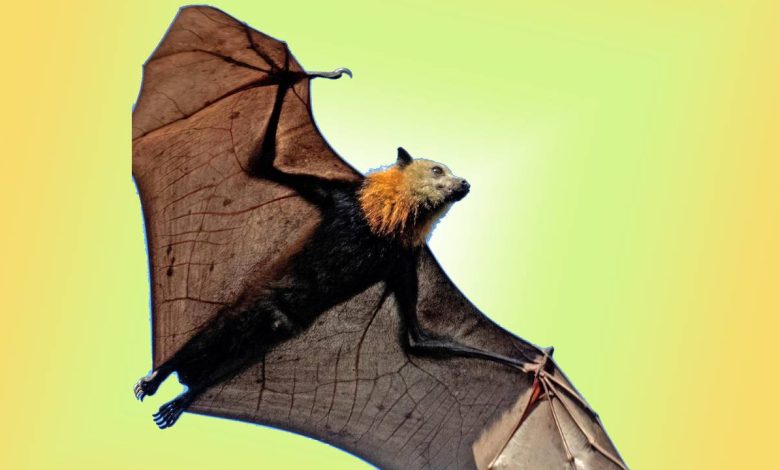
Context:-According to a recent study, the Indian Flying Fox bat, the largest species of bat found in India, is environmentally conscious during 7% of the time it spends roosting throughout the day.
Key points:-
- One of the largest genera of bats in the world is the flying fox, known to as the fruit bat.
- Most of them, but not all, are nocturnal.
- Because they pollinate plants, they help both ecosystems and humans.
About flying fox bat:-
Common name – Indian flying fox
Scientific name–Pteropus giganteus
Appearance-
- Dark grey, black, or brown in colour, flying foxes have a yellow or tawny mantle.
- Almost all of its body is black, with the exception of the rusty-red fur around its neck and the white-tipped hairs on its abdomen.
- Reddish-brown rings may be present around certain members of this species. Some bats also don’t have fur on their hind legs.
- The largest bats are called flying foxes, and some of them may grow as huge as 1.5 metres (5 feet) in wingspan and around 40 cm (16 inches) in length overall.
- It’s called a fox bat because the appearance is similarity like a small fox.
Habitat-
- The Little Red Flying-fox, the Black Flying-fox, the Grey-headed Flying-fox, and the Spectacled Flying-fox are the four Flying-fox species that are native to continental Australia.
- The Indian flying fox bat is one of the species of flying fox which is found in the Indian subcontinent.
- Flying foxes can be seen making their nests in caves, forests, and other types of woodlands. Flying-foxes congregate in huge roosts or camps.
- These are distributed to Pakistan, India, Nepal, Burma, Bhutan, Sri Lanka and Maldive Islands.
- These bats are endemic to South Central Asia, found from Pakistan and China to the Maldive Islands.
Diet:-
- These fox bats which fly over certain distances are essentially nocturnal species, they are active during the night and they forage on fruits,nectar etc. that is their primary source of food they rely on fruits.
- It is nocturnal and mostly consumes ripe fruits like mangoes and bananas as well as nectar.
Lifespan:-
Its lifespan is 15 years (wild), up to 30 years in captivity.
Reproduction:-
- Being polygynandrous (promiscuous), both males and females of this species mate many times in order to reproduce.
- The period from July to October is the breeding season. The period from July to October is the breeding season.
- 140–150 days of gestation result in 1-2 infants, who are typically born in February–May.
- These bats breed only sometimes.
Conservation:-
The Indian Flying Fox is listed as being in the Least Concerned category on the IUCN Red List. They are regarded as vermin and the spreaders of several dangerous diseases. The actual Nipah virus is one illustration.
Leaving lifestyle:-
- They hang upside down from trees or even cave-like structures and they are kind of a semi asleep cycle during the daytime.
- They are asleep while maintaining situational awareness,they are vigilant during daytime,they have unique sensory organs which keeps them vigilant for threats because they might face threats from predators from human beings from the environment itself.
- So even though the flying fox bat is asleep, some of the sensory organs are still active during day roosting to warn the bird about any threats in its nearby region.
- They often reside as a colony; they don’t stay individually.In a colony seen hundreds and hundreds of bats together.
- One which are resting on the outer periphery,they are more vigilant because the threat will first come to them.
- The ones inside the colony are a little more relaxed than others,they don’t maintain heightened vigilance.
Environmental and ecological effects:-
-
- The primary source of food it’s a fruit eating bat and it relies on nectar as well. It was considered as a vermin and a pest and was listed under schedule five of wildlife protection.
- The government could allow the hunting of the species as well if required as it was treated as vermin but later studies show that flying fox bat is a keystone species.
- It was recognized as keystone species highlighting it’s critical role in the ecosystem and since then it has been designated as protected species under schedule 2 of the wildlife protection act now this has given higher degree of protection for flying fox bats.
- Its protection status has been enhanced because it is a critical species in the ecosystem.
- Keystone species:- A keystone species is a species with a dramatically large effect on an ecosystem relative to its abundance.
- A keystone species is so critical to the ecosystem that if you remove that species from the ecosystem the whole ecosystem can collapse
- Entire food chains will be dependent on certain species so such a species which is having a huge disproportionate impact on the ecosystem compared to its population such important species are known as keystone species.
- So the flying fox bats are considered as keystone species, primarily because they eat which means they ingest the seed and they take the seeds far away and they help in seed dispersal.
- Through their droppings their excreta they dispose the seeds for a way this helps in seed dispersal and they play a critical role in the ecosystem.
Conclusion:-
So because of this dramatic disproportionate effect they have on the ecosystem compared to their population and size it’s recognized as one of the keystone species. That’s what a new study has found out.





.png)



